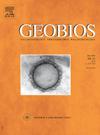A rare ‘flat-headed’ pachycephalosaur (Dinosauria: Pachycephalosauridae) from West Texas, USA, with morphometric and heterochronic considerations
IF 1.6
4区 地球科学
Q2 PALEONTOLOGY
引用次数: 0
Abstract
A juvenile pachycephalosaur frontal from the upper Aguja Formation (Late Cretaceous: middle Campanian) of West Texas, USA is unusually thin dorsoventrally, even compared to ‘flat’ frontals of young individuals pertaining to other pachycephalosaur taxa. The specimen is most comparable morphologically and morphometrically to Stegoceras validum. However, it is much thinner than any ‘juvenile’ example of that species, and also differs in the elongate form and radial arrangement of the surficial tubercles, as well as occurrence of radial grooves along the lateral margins of the bone. Such differences are unlikely a reflection of intraspecific variation. Instead, the Aguja specimen likely represents a previously unknown juvenile semaphoront from the southern Western Interior, referred herein to Stegoceras sp. and likely extends the distribution of this widespread Campanian genus. A morphometric evaluation suggests that the holotype specimen of Texacephale langstoni, also from the Aguja Formation, is probably an adult semaphoront of Stegoceras. However, both specimens represent different ontogenetic stages with dissimilar morphologies and so their potential conspecifity remains equivocal. The new Aguja specimen described herein likely represents a ‘paedomorphic’ Campanian pachycephalosaur – one where the onset of doming is displaced until well into ontogeny – a heterochronic attribute Stegoceras sp. shares with S. validum and Pachycephalosaurus wyomingensis. Where an adequate ontogenetic sample is available for comparison, other pachycephalosaur taxa do not seem to exhibit a similar growth progression, and so this appears to be a significant taxonomic characteristic. That some pachycephalosaurs delayed doming of the skull roof during growth is enigmatic, but it may have been an expression of sexual dimorphism, an aid in species recognition, or a response to harsh environmental conditions.
来自美国西得克萨斯州的罕见 "平头 "棘头龙(恐龙亚目:棘头龙科)及其形态计量学和异时性考量
美国德克萨斯州西部上阿古哈地层(晚白垩世:坎帕年中期)出土的一只幼年棘皮龙正面背侧异常纤细,即使与其他棘皮龙类群幼年个体 "扁平 "的正面相比也是如此。该标本在形态和形态计量学上与 Stegoceras validum 最为相似。但是,它比该种的任何 "幼年 "标本都要薄得多,而且在表面小瘤的细长形式和径向排列以及沿骨骼侧缘出现的径向沟槽方面也有所不同。这些差异不太可能是种内变异的反映。相反,Aguja标本很可能代表了西部内陆南部一种以前未知的幼年半齿龙,在这里被称为 Stegoceras sp.,并很可能扩大了这一广泛分布的坎帕尼亚属的分布范围。形态评估表明,同样产自阿古哈地层的 Texacephale langstoni 的主模式标本很可能是 Stegoceras 的成年半拟真体。然而,这两个标本代表了不同的发育阶段,形态各异,因此它们的潜在同种性仍然不明确。这里描述的新的 Aguja 标本很可能代表了一种 "paedomorphic "的坎帕尼亚棘头龙--这种棘头龙的穹顶开始阶段要到成熟期以后才会出现--这是 Stegoceras sp.与 S. validum 和 Pachycephalosaurus wyomingensis 的共同特征。在有足够的个体发育样本进行比较的情况下,其他棘头龙类群似乎没有表现出类似的生长进程,因此这似乎是一个重要的分类学特征。一些棘头龙在生长过程中推迟了颅顶的穹隆,这一点令人费解,但它可能是性二型的一种表现,有助于物种识别,或者是对恶劣环境条件的一种反应。
本文章由计算机程序翻译,如有差异,请以英文原文为准。
求助全文
约1分钟内获得全文
求助全文
来源期刊

Geobios
地学-古生物学
CiteScore
3.30
自引率
6.20%
发文量
28
审稿时长
6-12 weeks
期刊介绍:
Geobios publishes bimonthly in English original peer-reviewed articles of international interest in any area of paleontology, paleobiology, paleoecology, paleobiogeography, (bio)stratigraphy and biogeochemistry. All taxonomic groups are treated, including microfossils, invertebrates, plants, vertebrates and ichnofossils.
Geobios welcomes descriptive papers based on original material (e.g. large Systematic Paleontology works), as well as more analytically and/or methodologically oriented papers, provided they offer strong and significant biochronological/biostratigraphical, paleobiogeographical, paleobiological and/or phylogenetic new insights and perspectices. A high priority level is given to synchronic and/or diachronic studies based on multi- or inter-disciplinary approaches mixing various fields of Earth and Life Sciences. Works based on extant data are also considered, provided they offer significant insights into geological-time studies.
 求助内容:
求助内容: 应助结果提醒方式:
应助结果提醒方式:


